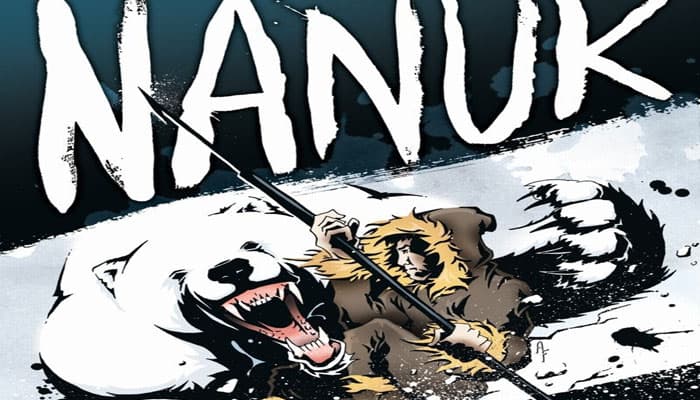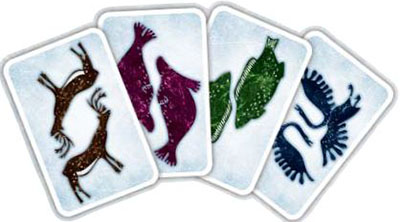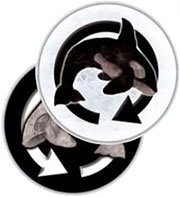
Nanuk is a card game for 5 to 8. The players are Inuit hunters in the Arctic, braving the wilderness to find food for the tribe.
The game is played in rounds, each of which has four phases: Boasting to decide who leads the hunt, Choosing Sides in which players decide whether to go on the hunt or stay home, Planning the Hunt, and Finishing the Hunt.
The more days a hunt lasts, the better the chance that the hunters will find the game they need . . . but the greater the danger of encountering Nanuk, the polar bear, ending their hunt in disaster.

Components
- 100 cards
- Gameboard
- 3 Wind Tokens
- 1 Day Token
- 10 Number Tokens
- 10 Hunt/Doom Tokens
- Rulesheet
Setup
For the first round, the dealer (and first player) is whoever has been furthest north. Shuffle the deck. Deal each player a hand of three face-down cards. Give each player a Hunt/Doom token.
The Cards
Most cards show a Deer, Seal, Fish, or Bird. There are 24 of each animal card. They are the object of the players' hunts.

Each type of animal has the same value . . . they are different, but no one is better than any other. Three of each type of animal are "double". A double counts as two animals during a hunt, and is scored as two cards at the end of the game.

Twelve of the animal cards have bears in the corners. These are Nanuk cards. If drawn during the hunt, Nanuk brings doom unless you are protected by an Inuksuk. However, these cards give bonuses when scoring.
The Inuksuk cards (right) represent guideposts in the wilderness. They protect against Nanuk on the hunt. There are only four.
Card Management
The game starts with all the cards in the draw deck. As play continues, some cards will be won by players. Others will be discarded.
If there are discards, they are placed face up at the bottom of the draw deck. This makes it difficult to see just how many cards are left to draw. When a face-up card appears, the game is over or almost over.
Each player will own two sets of cards as the game progresses:
Hand. You will start each hunt with three cards in your hand. The other players can't see your hand.
Score. These are the cards you win by successful hunting or dooming. They are all kept face up, and organized into sets and pairs.

The Wind Token
At the beginning of each round, the first player flips the Wind token to determine the direction of play around the table.
Place the Wind token in the circle at the top of the board.
Days and Numbers

The Day token shows the sun, and is used on the gameboard to show the number of days in the current bid.
The Number tokens are placed on the board to show the number of animals in the current bid. The type of animal is shown by the board space on which the tokens are placed.

The Hunt/doom Tokens

Each player has one of these tokens. One side is brown, with crossed spearheads. This side is used to indicate that the player is going on the hunt.
The other side is red, with the skull of a Nanuk. This side is used to indicate that the player is staying home, because he believes this hunt is DOOMED!

Game Play - Hunts
Each round represents a new hunt. At the beginning of each round, the Day Track is set to 1. The first player flips the Wind token.
This will determine the direction of bidding around the table, and, in later phases, the direction of play of hunting cards and the choice of reward cards.
Boasting
The boasting begins with the first player and continues around the table in the direction of the wind. Each player must either raise the boast, or declare that the hunt is doomed. Players may not pass.
Each boast is a bid. When you boast, you are saying how much the group will bring back if you are the leader, and how long you'll be able to brave the wilderness.
The minimum first bid is "1 animal in 1 day", which is a very easy hunt. Boasts may be made in Birds, Fish, Seals, or Deer, and each bid can name only one type of animal.
When you make a boast, move the tokens on the board to show your bid. You may raise the previous boast by:
Raising the days: A boast of 1 Fish in 4 days is better than a boast of 1 Fish in 3 days, since longer hunts can find more game . . . and are more dangerous. The maximum number of days that can be bid is 12. Once the marker reaches 12, the days can't be raised further.
Raising the number of animals: A boast of 2 Seals in 4 days is better than a boast of 1 Seal in 4 days. If you raise the number of animals, you
Raising both days and animals!
Players can raise the previous boast by any amount. For instance, a player may respond to "2 Deer in 4 days" by saying "6 Fish in 7 days".
 6 Fish in 7 Days |
A successful boast will take into account your own cards, as well as your best estimate of the other players' cards.
If a player does not want to raise the last bid, he has an alternative . . . he can say that the last boast is impossible and the hunt is DOOMED!
Once someone says the hunt is doomed, the bidding is over and the next phase starts.
Choosing Sides
When a player says that the hunt is doomed, that player becomes the Doom Leader, and may not join the hunt. He puts his token on the table, Doom side up.
The previous player - that is, the last one to make a boast - becomes the Hunt Leader. His boast, whatever it was, becomes the object of the hunt. Place the Wind token between these two players. The Hunt Leader automatically goes on the hunt, so he places his token on the table in front of him, Hunt side up.
The Doom Leader should say "DOOMED!" as forcefully as he can! After he dooms the hunt, he may try to persuade the other players to stay out of the hunt. If he can talk enough of them out of participating, the hunt will fail.
Likewise, the Hunt Leader can try to talk the other players into coming with him to hunt. The more players who hunt, the more likely it is that the hunt will succeed.
The other players may argue for either side.
Note that at this stage only the Hunt Leader and Doom Leader are committed. Other players may even argue for one side and then decide to choose the other . ..
However, no player can show his cards.
Each other player secretly decides whether or not to join the hunt. To show your choice, place the Hunt/Doom token with its chosen side up under your hand, and push it toward the center of the table.
After all the players have their hands out, showing that their decisions are made, the tokens are revealed all at once. If a player makes a mistake and puts his token out wrong side up, he is bound to what his token shows!
Players should leave their tokens out, showing whether they are Hunters or Doomers, until the beginning of the next round.
Placing the Ante
Each player who said the hunt was Doomed now chooses a card from his hand and places it face- down in front of him, under his Doom token. This is his "ante". After the hunt is over, whether it succeeds or fails, all the ante cards are turned face-up and added to the pot which the winners will share.
Planning the Hunt
Each Hunter, one at a time, must contribute at least one card from his hand to the hunt. The first card(s) are played by the next Hunter, in the direction of the wind, from the Hunt Leader. Then each Hunter, in turn, contributes his card(s). The Hunt Leader makes his contribution last.
All the cards are played face-down to the center of the table. Everyone may see how many cards are contributed by each player, but not what they are!
After the Hunt Leader makes his own contribution, he takes all the cards and mixes them up, so no one can see who played which card. Then he turns them face up to see how the hunt will begin:
Cards matching the hunt's target animal will count toward the number needed for this hunt. It doesn't matter whether these cards have Nanuks on them.
Each Inuksuk card will protect the hunt by canceling one Nanuk drawn from the deck in the next phase.
Animals that don't match the target animal don't help or hurt the hunt.

Finishing the Hunt
The Dealer draws cards from the deck, one at a time, to complete the hunt. Each card represents a day of the hunt. A one-day hunt gives one card, a two-day hunt gives two, and so on. Continue until a card has been drawn for every day, or until Nanuk appears . ..
Look at the corners of each card turned up - that's where the Nanuk symbol is. If a Nanuk card appears, and no Inuksuk is showing, stop drawing cards. The hunt has failed!
But remember, any Inuksuk card showing - either in the cards contributed by the Hunters, or in the cards drawn for earlier days - cancels one Nanuk. Each Inuksuk can cancel only one Nanuk, so if there are ever more Nanuks drawn than Inuksuks, the hunt immediately fails.
After a card has been drawn for each day of the hunt, if the target number of animals has been met, the hunt succeeds. If there are not enough animals, the hunt fails.
If the target number of animals is reached, but there are still days to go, the Dealer must continue drawing cards until one has been turned over for each day of the winning boast.
Winter is Near . .
If you reach the face-up cards at the bottom of the deck while you are drawing days, this will be the last hand. Stop drawing cards (the face-up card does not count).
All the players return their hands to the Dealer, who shuffles them in with the discards to form a new draw deck. The remaining days are drawn to finish the hunt. Once the current hunt has been resolved, the game is over, and players will score their cards.
In the unlikely event that there are not enough reshuffled cards to complete the hunt, the game ends. There is no score for the uncompleted hunt.
Rewards of Hunting
If a hunt is successful, the Hunters will share all the cards from the hunt . . . those they contributed to start with, all cards turned up from the deck, and the "ante" cards of the Doomers.
Each Hunter will get the same number of cards. Starting with the Hunt Leader, and going in the direction of the wind, each Hunter chooses a single card. If there are enough cards left for each Hunter to take another, go around again, and so on. The leftovers are discarded (see below).
If each player keeps his reward cards in front of him until all have been drawn or discarded, it will make it easier to keep track of who still gets to draw cards.
Example: If there are six Hunters and 13 cards, each hunter will get two, with one left over.
The leader will choose one card, then the next player will choose one, and so on, twice around the table. After each player has chosen a second card there will be one left over. Discard it.

Rewards of Doomsaying
If a hunt fails, the Doomers will share all the cards from the hunt, starting with the Doom Leader, in the same way described above for Hunters.
Discards
Any cards left over are discarded. They are placed face-up under the draw deck.
New Cards
After the hunt is resolved, whether it was a success or a failure, each player is dealt face- down cards to bring his hand up to three.
If a face-up card appears while the new cards are being dealt, or is on top of the deck after all are dealt, the game ends immediately, and players will discard any cards already dealt and count their scores - see Winning the Game, below.
The Next Round
A new round begins after cards are dealt to the Hunters. The first player is the successful leader in the previous round . . . the Hunt Leader if the hunt succeeded, the Doom Leader if it failed. He will flip the wind token and make the first boast.
End of the Game
After each hunt, players collect their scoring cards into sets and pairs. At the end of the game they calculate their scores. Each card may be used only once. Double-animal cards break this rule, and can be used as two separate cards.
A set of one of each animal (that is, a set of four different animal cards) is worth three points.
Any pair of matching Deer, Seal, Fish, Bird, or Inuksuk cards is worth one point.
Inuksuks are wild cards, and may be used to fill any pair or set.
The player with the most Nanuk cards scores two bonus points. If there is a tie for most Nanuks, each tied player gets one point.
The high scorer is the winner.
Longer Games
Players may decide in advance to play several seasons, and determine the mightiest hunter by totaling the scores from all seasons.
The winner of one season becomes the first player in the next game, and so on. In case of ties, the first player for the next game is chosen randomly from among the tied players.
Optional Rule
The decisions to Hunt and Doom are not simultaneous. Instead, once someone declares the hunt is doomed, the next player in the direction of the wind immediately declares which side he will join, and turns his token to the appropriate side.
Then the next player decides, and so on. Players may not change their decisions! Once each player has chosen to Hunt or to Doom, the Doomers place their antes and the Planning the Hunt phase begins.
Continue Reading
